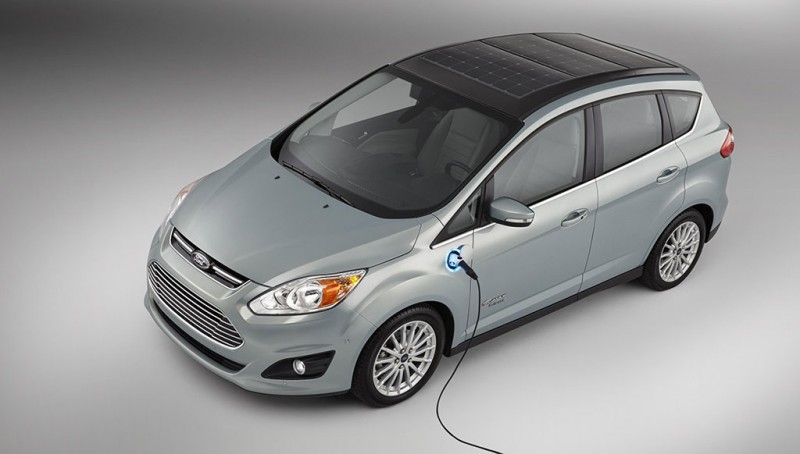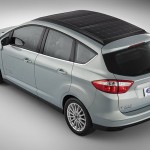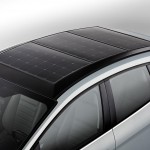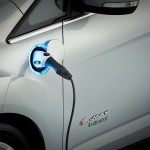Today sees a first of it’s kind concept plug-in hybrid vehicle that features a solar panel roof to provide energy rather than the national grid reliance current vehicles offer.
The Ford C-MAX Solar Energi Concept powers it’s electric drivetrain using concentrators on the solar panels allowing them to be more efficient and produce more power than conventional panel arrays would. The result is a relatively ordinary looking C-MAX with a slightly raised roof profile to allow for the extra technology.
The achievement is significant as it is one of the first solar power aided vehicles, rather than the likes of older attempts to make a vehicle solely reliant on the power of the sun. Instead, the C-MAX Solar Energi Concept is able to run off the sun and constantly recharge on the fly – except at night. Powered by a conventional internal combustion engine (ICE) the rest of the time, the car is a traditional plug-in hybrid vehicle (PHEV) with a subtle difference.
The result is a concept vehicle that takes a day’s worth of sunlight to deliver the same performance as the conventional C-MAX Energi plug-in hybrid, which draws its power from the electric grid. Ford C-MAX Energi gets a combined best miles per gallon equivalent in its class, with EPA-estimated 108 MPGe city and 92 MPGe highway, for a combined 100 MPGe. By using renewable power, Ford C-MAX Solar Energi Concept is estimated to reduce the annual greenhouse gas emissions a typical owner would produce by four metric tons.
Mike Tinskey, Ford global director of vehicle electrification and infrastructure, said:
“Ford C-MAX Solar Energi Concept shines a new light on electric transportation and renewable energy. As an innovation leader, we want to further the public dialog about the art of the possible in moving the world toward a cleaner future.”
C-MAX Solar Energi Concept, which will be shown at the 2014 International CES in Las Vegas, is a collaborative project of Ford, San Jose, Calif.-based SunPower Corp. and Atlanta-based Georgia Institute of Technology.
Strong electrified vehicle sales
The C-MAX Solar Energi Concept debuts as Ford caps a record year of electrified vehicle sales.
Ford expects to sell 85,000 hybrids, plug-in hybrids and all-electric vehicles for 2013 – the first full year its six new electrified vehicles were available in dealer showrooms.
C-MAX Energi is Ford’s plug-in sales leader, with sales of more than 6,300 through November. Ford sold more plug-in vehicles in October and November than both Toyota and Tesla, and it outsold Toyota through the first 11 months of 2013. Plug-in hybrids continue to grow in sales as more customers discover the benefits of using electricity to extend their driving range.
C-MAX Hybrid over the last year has been a key driver in helping Ford sell more hybrids than any other automaker in the United States, second only to Toyota. C-MAX Hybrid continues to bring new customers to the Ford brand, with a conquest rate of 64 percent and drawing nearly half of its sales from import brands. Conquest rates are even higher in key hybrid growth markets like San Francisco, Los Angeles and Washington, D.C.
Breakthrough clean technology
SunPower, which has been Ford’s solar technology partner since 2011, is providing high-efficiency solar cells for the roof of Ford C-MAX Solar Energi Concept. Because of the extended time it takes to absorb enough energy to fully charge the vehicle, Ford turned to Georgia Institute of Technology for a way to amplify the sunlight in order to make a solar-powered hybrid feasible for daily use.
Researchers developed an off-vehicle solar concentrator that uses a special Fresnel lens to direct sunlight to the solar cells while boosting the impact of the sunlight by a factor of eight. Fresnel is a compact lens originally developed for use in lighthouses. Similar in concept to a magnifying glass, the patent-pending system tracks the sun as it moves from east to west, drawing enough power from the sun through the concentrator each day to equal a four-hour battery charge (8 kilowatts).
With a full charge, Ford C-MAX Solar Energi Concept is estimated to have the same total range as a conventional C-MAX Energi of up to 620 miles, including up to 21 electric-only miles. Additionally, the vehicle still has a charge port, and can be charged by connecting to a charging station via cord and plug so that drivers retain the option to power up via the grid, if desired.
After C-MAX Solar Energi Concept is shown at CES, Ford and Georgia Tech will begin testing the vehicle in numerous real-world scenarios. The outcome of those tests will help to determine if the concept is feasible as a production car.
Off-the-grid car
By tapping renewable solar energy with a rooftop solar panel system, C-MAX Solar Energi Concept is not dependent on the traditional electric grid for its battery power. Internal Ford data suggest the sun could power up to 75 percent of all trips made by an average driver in a solar hybrid vehicle. This could be especially important in places where the electric grid is underdeveloped, unreliable or expensive to use.
The vehicle also reinforces MyEnergi Lifestyle, a concept revealed by Ford and several partners at 2013 CES. MyEnergi Lifestyle uses math, science and computer modeling to help home owners understand how they can take advantage of energy-efficient home appliances, solar power systems and plug-in hybrid vehicles to significantly reduce monthly expenses while also reducing their overall carbon footprint.
The positive environmental impact from Ford C-MAX Solar Energi could be significant. It would reduce yearly CO2 and other greenhouse gas emissions from the average U.S. car owner by as much as four metric tons – the equivalent of what a U.S. house produces in four months.
If all light-duty vehicles in the United States were to adopt Ford C-MAX Solar Energi Concept technology, annual greenhouse gas emissions could be reduced by approximately 1 billion metric tons.
Source; Ford




